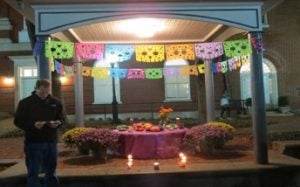Día de Los Muertos: A Celebration of Culture and Death on the Hilltop
A makeshift ofrenda (altar) is set in Dahlgren quad under the gazebo. The round stone monument is covered with a rich purple tablecloth, candles with the Virgen de Guadalupe (Virgin of our Lady of Guadalupe) on them, flowers, fruit, calaveras (sugar skulls) and pan de muerto (bread of the dead). The sun is set; the dim lighting of the quad, coupled with the flame of the candles, creates a close knit atmosphere as a steady stream of students form a semicircle around the ofrenda. Pictures of loved ones are placed on the ofrenda as Father Carnes begins the prayer. He prays in Spanish from the small book in his hand for the souls of those who have passed away, and then turns his head to the students to reflect on this beautiful holiday.
prayer. He prays in Spanish from the small book in his hand for the souls of those who have passed away, and then turns his head to the students to reflect on this beautiful holiday.
What is this holiday? It’s called Día de Los Muertos (Day of the Dead), a celebration that takes place in early November alongside two Catholic feast days: All Saints Day (Nov. 1) and All Souls’ Day (Nov. 2). Día de Los Muertos originated, and is largely celebrated, in Mexico and Central America, in addition to Italy, Spain, and the Philippines. The celebration is a mixture of Mexican indigenous beliefs and Catholic tradition, originally brought to these areas by Spanish invaders. At the core of the celebration is the belief that death should be celebrated out of respect and love for the dead. Over the course of both days, families celebrate their dead in a number of ways. As described above, one way to honor the dead is to create an ofrenda, or altar, full of things like flowers, peanuts, fruits, bread, and photographs and mementos of the deceased. Other ways include: visiting and cleaning graves; putting on parades; dancing; decorating candied skulls called calaveras; and, painting one’s face with skeleton imagery. The pan de muerto, a sweet bread made for the holiday, is eaten in addition to other traditional cuisine. Masses for All Saints Day and All Souls Day are celebrated along wit h the festivities, as everyone takes time to remember and honor their loved ones.*
h the festivities, as everyone takes time to remember and honor their loved ones.*
Here on campus, I’ve been lucky enough to participate in this symbolic holiday. As a student leader in an organization on campus called MEChA (Movimiento Estudantil Chicano de Aztlan) de Georgetown, a student group on campus for U.S. Latinxs**, I’ve helped to organize Día de Los Muertos celebrations, like the one described above, for two years. After the prayer at the ofrenda, we celebrate with calaveras, hot chocolate, food, face painting, and music. It’s one of my favorite events of the school year – and not just because the food is good (although I do appreciate a warm cup of hot chocolate in November). For me, this holiday is a rare instance at Georgetown in which my Latina heritage and my Catholic identity intersect in a very tangible way. At home in Arizona, which has a large Latinx population, I’m keenly aware of and immersed in the strong Latinx Catholic Church. On the Hilltop, that intersection isn’t always as visible. Further, Día de Los Muertos is a reminder of the Church’s profound impact in Latin America, and the ways in which indigenous cultur e has merged with Catholicism. On campus, I see this day as another sort of merger—where la cultura (culture) meets Georgetown.
Catholic Church. On the Hilltop, that intersection isn’t always as visible. Further, Día de Los Muertos is a reminder of the Church’s profound impact in Latin America, and the ways in which indigenous cultur e has merged with Catholicism. On campus, I see this day as another sort of merger—where la cultura (culture) meets Georgetown.
This year will be my third year organizing the celebration of Día de Los Muertos, this time as co-chair of MEChA. I find that remembering our loved ones who passed away is something that students of many (or no) faith backgrounds and all ethnicities can appreciate and have appreciated in the past. Death is by no means easy to deal with all the time, but I have found comfort in my fellow Hoyas during this holiday, a sentiment shared by many. I encourage you to join us (or the other celebrations on campus) this year as we celebrate this beautiful holiday, whether f or the first time or if you’ve celebrated before. I invite you to learn about another culture’s way of honoring the dead and the joy that community brings; keep an eye out for advertisements from MEChA and the GU Mexican Student Association to find out more. As a Catholic, I find hope in the Resurrection and peace in celebrating both life and the lives of those whose time on this Earth has come to an end.
or the first time or if you’ve celebrated before. I invite you to learn about another culture’s way of honoring the dead and the joy that community brings; keep an eye out for advertisements from MEChA and the GU Mexican Student Association to find out more. As a Catholic, I find hope in the Resurrection and peace in celebrating both life and the lives of those whose time on this Earth has come to an end.
Written by Alexis Larios, C’18
(Photos courtesy of MEChA de Georgetown)
*Historical information comes from National Geographic
**Latinx (lah-teen-ex) is a gender-neutral form of Latino/Latina
For more on the holiday, this short video is a great artistic representation: https://www.youtube.com/watch?v=jCQnUuq-TEE
- Tagged
- Catholic